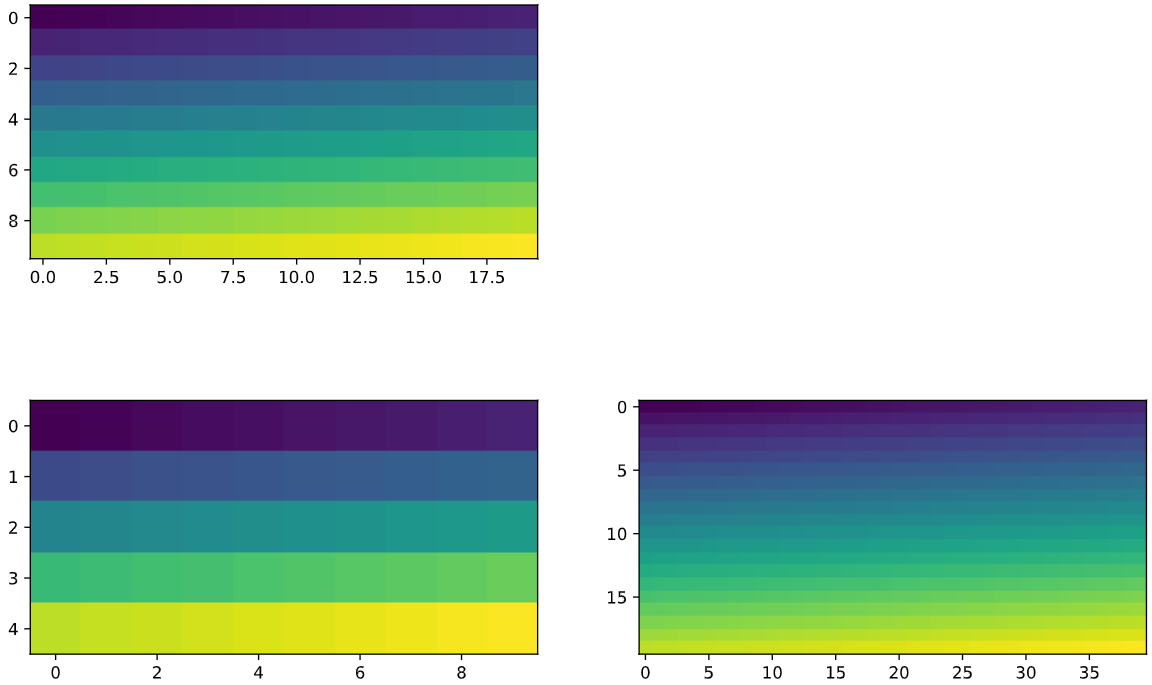[Python scipy] Upscaling / Downscaling von 2D-Daten
Vokabelbuch. Viel nachdrucken, weil es schwierig ist, jedes Mal zu suchen. Es gibt eine ursprüngliche URL.
Manchmal wird es verwirrend:
--Opscale: Grobe Auflösung --Downscale: Feinere Auflösung
Die Wertinterpolation ist hier zusammengefasst: [SciPy.org: Interpolation (scipy.interpolate)] (https://docs.scipy.org/doc/scipy-0.14.0/reference/interpolate.html)
Von diesen diejenige, die häufig für Upscale / Downscale verwendet wird
- interp2d
- Nur 2 Dimensionen.
kind= ‘linear’, ‘cubic’, ‘quintic’
- RegularGridInterpolator
- Kann in anderen als 2 Dimensionen verwendet werden
- Muss "reguläres Gitter" sein (nicht unbedingt gleichmäßig verteilt)
method= 'linear', 'nearest'
- Schneller als "intrep2d", wenn dies in Ordnung ist
Beispiel mit RegularGridInterpolator
[stackoverflow: Scipy interpolation with masked data?] (https://stackoverflow.com/questions/35807321/scipy-interpolation-with-masked-data) Ist leicht zu verstehen. Im Fall von MaskedArray ist es schneller, die Maske selbst zu konvertieren (anstatt den maskierten Teil mit np.nan zu füllen).
import numpy as np
from scipy import interpolate
def conv_resol(arr, newshape, *args, **kwargs):
'''
Args:
arr [2d ndarray or MaskedArray]
newshape [tuple of int]
*args, **kwargs: for interpolate.RegularGridInterpolator
'''
nx0, ny0 = arr.shape
nx1, ny1 = newshape
x0 = np.linspace(0, 1, nx0)
y0 = np.linspace(0, 1, ny0)
x1 = np.linspace(0, 1, nx1)
y1 = np.linspace(0, 1, ny1)
x1, y1 = np.meshgrid(x1, y1) # x1 [ny1,nx1], y1 [ny1, nx1]
xy1 = np.array((x1, y1)).T # xy1 [nx1, ny1, 2]
arr1 = interpolate.RegularGridInterpolator((x0, y0), arr, *args, **kwargs)(xy1)
if isinstance(arr, np.ma.MaskedArray):
mask1 = interpolate.RegularGridInterpolator((x0, y0), arr.mask.astype('float'), *args, **kwargs)(xy1) > 0.0
return np.ma.masked_array(arr1, mask=mask1)
return arr1
Prüfung
import matplotlib.pyplot as plt
nx0, ny0 = 10, 20
arr0 = np.arange(nx0 * ny0).reshape(nx0, ny0) * (1.0 / (nx0 * ny0))
nx1, ny1 = 5, 10
arr1 = conv_resol(arr0, (nx1, ny1))
nx2, ny2 = 20, 40
arr2 = conv_resol(arr0, (nx2, ny2))
plt.figure(figsize=(12,8))
plt.subplot(2,2,1)
plt.imshow(arr0, vmin=0.0, vmax=1.0)
plt.subplot(2,2,3)
plt.imshow(arr1, vmin=0.0, vmax=1.0)
plt.subplot(2,2,4)
plt.imshow(arr2, vmin=0.0, vmax=1.0)

Recommended Posts